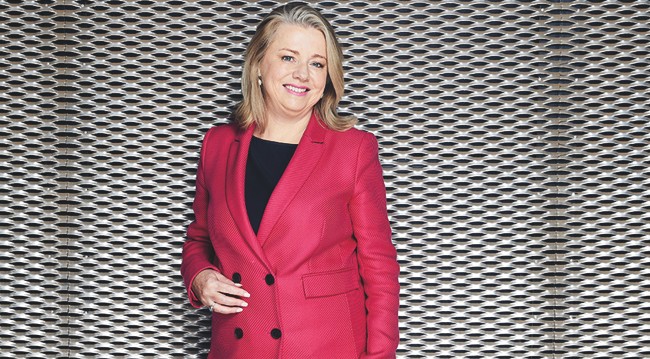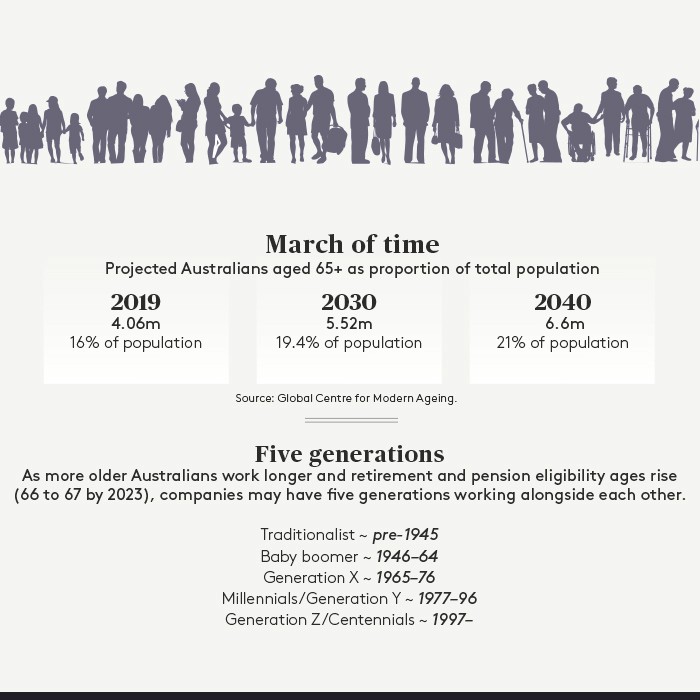As older employees are continuing to work, Julianne Parkinson, CEO of the Global Centre for Modern Ageing, discusses the untapped opportunities in Australia's ageing population.
In 1950, the path from the office to the grave was a short one. For men, at least. The average Australian male retired at 65 and was statistically likely to die just two years later. Retirement wasn’t considered a time for trying new things — or even enjoying oneself. In that era, most Australian women did not participate in paid employment, while their domestic duties continued, much unchanged, into their later years.
Today, Australians have among the world’s highest life expectancies, with men living to an average age of 80, and women to 84. This change in demographic is set to become more pronounced over time. According to World Economic Forum estimates, a child born in the developed world today has the potential to live past 100.
Dr Kay Patterson AO GAICD, Age Discrimination Commissioner at the AHRC, says bringing about positive change and greater workplace inclusion should be led by company directors.
“Why aren’t directors having annual discussions with HR teams about the number of older workers on their teams?” she asks. “They may be having those discussions about gender diversity and other types of diversity, but they never mention ageing workers. Older people might be really well represented in directorships, but we’re talking about directors taking an interest in the value of employing older people in the workforce.”
Time and money
Given the trend to living and working longer, Global Centre for Modern Ageing (GCMA) CEO Julianne Parkinson (pictured below) is surprised older people are often forgotten by marketing and product development teams. While people aged over 65 constitute 15.7 per cent of the population — the fastest-growing demographic — they feature in only 4.7 per cent of advertisements. Even then, according to the Australian Human Rights Commission (AHRC), they are only targeted for a limited range of products. “Companies say: it’s not that we’ve intentionally not thought about older people — we just haven’t thought about them in either our workforce or customer mix,” she says.
The catalyst for GCMA arose in 2014, when the Economic Development Board (South Australia) looked at what could be done to revitalise the state economy, given manufacturing was in decline and SA had a higher percentage, per capita, of people over 65. “We saw that ageing could be seen not as a burden, but as a real opportunity for business,” says GCMA chair Raymond Spencer. “Older people were an ill-defined sector who got lumped into one big group — but that’s like putting adulthood into one category.”
Through advocacy, market development, partnerships, research and learning, GCMA helps organisations and individuals to devise, build and commercialise products and services that allow older people to live and age well. It is a not-for-profit entity with an enterprise ethos — meaning it operates on commercial terms, including a fee-for-service basis.
The centre was established in March 2018 and formally launched in October that year with support from the SA government. The aim was to help companies better understand the needs and preferences of older people and aid them in discovering market opportunities. Parkinson observes the innovative technology industry, specifically home automation, is an area that is ripe for growth, as it promotes independence and lessens social isolation. Other emerging areas include health and wellbeing, nutrition, finance, tourism, hospitality, housing and retail precincts, and learning and education.

In 1992, it became evident Australia would experience a major demographic shift in coming decades as an ageing population, requiring pensions, would place a huge strain on the economy. A scheme was introduced that included compulsory employer contributions into superannuation funds as part of a wider reform package addressing Australia’s retirement income dilemma. As a result, today’s retirees have more time and funds at their disposal — an increasingly significant market group.
By 2030, the 60-plus age group will account for 60 per cent of total urban consumption growth in Western Europe and north-east Asia, according to a McKinsey report, The Global Consumers to Watch. While the study doesn’t have Australia-specific figures, it is reasonable to suggest Australia will have a similar outlook.
According to Parkinson, previous business models are being turned on their heads as consumption patterns among older people change. She cites packaging as one example. “In the past, food packaging for people in their seventies might have been the domain of the traditional aged care provider,” she says.
“It was a business-to-business sale from the food packaging company to the aged care provider, whereas now it is a retail sale between the individual and supermarket. Nowadays, people are living at home for longer and supermarkets will be stocking an increasing number of products for this group on their shelves.”
Parkinson believes even the midday meal in the kitchen is an outdated concept, as it doesn’t take into account significant lifestyle changes.
“Many older people aren’t at home for the midday meal anymore,” she says. “They’re on flights, eating off an airline’s tray table. Or they’re at a music festival, or they’ve taken a picnic up in the hills on the back of their Harley.”
Consumer behavioural information shows older consumers spend more on themselves instead of saving it up for their heirs. According to the Australian Bureau of Statistics, 86 per cent of Australians attended at least one cultural venue in 2013–14; for people over 75, the figure was 66 per cent. Classical music concerts were one area where a greater proportion of older people attended — 14 per cent of people aged 65–74, compared with seven per cent of 18–24-year-olds. And people in their sixties take roughly as many short overseas holidays as people in their twenties.
Parkinson says this is what modern ageing looks like, and it is ripe with business opportunities. “We want companies to understand that, just like other generations, older people are living better and more expensive lives,” she says. “This means products and services have to aid them wherever they go in the course of their day or evening.”
Readymade market
Older people are a fast-growing population group. In 2017, there were 3.8 million Australians over the age of 65. According to an Australian Institute of Health and Welfare (AIHW) report, this figure will rise to nearly six million by 2031.
“Getting involved in this older market isn’t just about a curiosity for your business or a short-term growth strategy,” says Parkinson. “This has a return on investment for decades to come if it’s done well.”
There are also opportunities on Australia’s doorstep in Asia, which will have the oldest population in the world in the next few decades. South Korea and Japan are ageing the fastest — Japan’s elderly population will make up 37.3 per cent of its total within a decade. By 2057, the AIHW projects there will be 8.8 million older people in Australia comprising 22 per cent of the population. Both governments and entities are actively seeking out products and services to benefit older people.
“The city of Hong Kong has established a HK$1b Innovation and Technology Fund to purchase products and services from around the world to allow its older citizens to age well,” says Parkinson. “So our message to businesses is this — if you get it right in an Australian setting, the export opportunities are very real.”
Ageing is, of course, a global phenomenon and responding to it will require global partnerships, which GCMA hopes to help cultivate. It has significant global expertise with Dr John Beard, former head of the World Health Organization’s (WHO) Department of Ageing and Life Course, a member of the board. Beard oversaw the development of WHO’s Global Strategy and Action Plan on Ageing and Health, which sets out ways to prepare for a Decade of Healthy Ageing from 2020–30. Some of the recommendations include developing age-friendly environments, aligning health systems to the needs of older populations and creating sustainable and equitable systems for long-term care.
“The board has a very diverse group of people — some with strong business backgrounds, some with strong academic backgrounds. You want that kind of balance,” says Spencer.

Living laboratory
The GCMA runs a test facility called LifeLab, a studio fitted out with cameras and sensors to allow observation of prototypes and products.
A recent pilot project involving Potatoes SA and the University of Adelaide aimed to develop new nutrient-enriched food products using potato puree as the base ingredient. Older people were invited to sample the products inside LifeLab’s dining room and give feedback on the look, feel and taste, as well as aspects such as the product’s nostalgic appeal and recycling potential.
Other collaborations have included co-designing aged care facilities, designing smart homes, and working with a bank on financial products and services. LifeLab’s team is also studying the experiences of the residents of a Port Elliot retirement village — who use a driverless vehicle developed by autonomous vehicle specialist company Aurrigo.
LifeLab’s executive director is Finnish cognitive scientist Veera Mustonen, who brings expertise as deputy CEO of innovation company Forum Virium Helsinki. LifeLab is one of just 12 “living labs” around the world specialising in ageing. Three thousand older people have signed up to participate in trials in which they will play the role of co-designer or end-user of a range of products and services. LifeLab is on track to be accredited this year by the European Network of Living Labs (ENoLL).
“Despite having ‘European’ in its name, ENoLL has become the global standard for living laboratories,” says Spencer. “It’s really important we operate at that level from a governance perspective, with the requisite ethics advisory practices and oversight. We’re really excited because we’ll be the only lab in Australia with that kind of accreditation and it will give us a great deal of credibility.”
Facing facts
Parkinson says the “modern” in GCMA signals it is looking at ageing with a fresh lens and urging others to do the same. The greatest challenge to achieving this is ageism.
“Ageism is pervasive,” says Parkinson. “It leads to older people being marginalised in our communities and negatively impacts their health and wellbeing.”
She believes common misconceptions about older people are that they don’t take risks, spend money or enjoy using digital technology. “It’s simply not the case,” she says.
GCMA’s research and insights division disseminates information about older people to correct harmful stereotypes. Parkinson points to the fact that the highest number of entrepreneurs in Australia are over the age of 54; and also to a 2018 Nielsen Report, which found many baby boomers are keeping pace with changing technologies.
New research by Victoria’s Swinburne University of Technology and the Queensland University of Technology shows Australians aged 55–64 are the fastest-growing group of entrepreneurs in the country. Tagged “seniorpreneurs”, this group achieved an activity rate of eight per cent, well above the three per cent average of innovation-driven economies. These figures are no surprise when you see that 34 per cent of all Australian business owners are aged 55–64.
“People are not retiring from work and giving back their iPads and smartphones,” says Parkinson.
Although there are record numbers of older people in the workforce, discrimination is rife. A 2013 AHRC report found up to 30 per cent of Australian employers were reluctant to hire workers over a certain age. For more than 65 per cent of this group, that age was anything over 50. The survey also revealed widespread prejudice against older people, stereotyping them as forgetful, short-tempered, rigid and backwards-looking.
Age and the workforce
When it comes to employing older workers, some companies fall short while others measure up. Joanna Maxwell looks at the advantages of disregarding age discrimination.
Did you know about 30 per cent of Australian employers still have an age above which they’re reluctant to hire workers — and for more than two thirds of this group, that age is 50?
This is one of the findings of a new survey examining attitudes to older workers conducted by the Australian Human Resources Institute (AHRI).
The good news is that 28 per cent of respondents said they definitely had no reluctance to employ older workers (up from eight per cent in the 2014 survey).
Age Discrimination Commissioner Dr Kay Patterson AO GAICD finds this progress encouraging.
“Age discrimination in employment is tied to damaging, dated and inaccurate ideas about older workers,” she says.
“It is heartening to see more recruiters don’t see age as a barrier. And the age at which people define ‘older’ has shifted upwards to 61 years or more. As we live longer and healthier lives, it is crucial for people to be able to contribute through the paid workforce, which is not only good for the economy and workplaces, but contributes to a sense of meaning and purpose for individuals.”
Survey respondents see advantages in employing older workers, including the experience they bring (76 per cent) and their professional knowledge (68 per cent). Interestingly, while almost two-thirds of the sample group (63 per cent) recognise that when an older worker leaves they take key skills with them, only 26 per cent of organisations methodically capture corporate knowledge from departing employees.
AHRI CEO Lyn Goodear GAICD said the demographic group leaving the workforce in significant numbers at present is largely made up of the cohort born in the years after WWII. “That is a disproportionately large cohort, yet only 21 per cent of respondents to this study report their organisation engages in phased retirement practices as a way to manage the loss of intellectual capital.”
Stereotypes and myths about older workers are still common — “you can’t teach an old dog new tricks”, “older workers aren’t committed”, “you get more stupid as you age”. There is overwhelming evidence to disprove these myths, but they still linger. So it is encouraging to see an increase since the last survey in the percentage of respondents who see no difference between the generations at work across a range of categories, including a 14 per cent increase in people indicating no difference on technology skills and abilities, a positive sign that the so-called “digital divide” is shrinking.
Overall there are solid gains, but much remains to be done. How does your organisation stack up on older workers?
Latest news
Already a member?
Login to view this content


